Title search results
Showing 1 - 20 of 1496 items
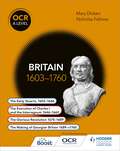
OCR A Level History: Britain 1603-1760 (OCR A Level History)
By Nicholas Fellows, Mary Dicken. 2015
Exam Board: OCRLevel: A-levelSubject: HistoryFirst Teaching: September 2015First Exam: June 2016This is an OCR endorsed resourceBuild strong subject knowledge and…
skills in A Level History using the in-depth analysis and structured support in this tailor-made series for OCR's British period studies and enquiries.- Develops the analytical skills required to succeed in the period study by organising the narrative content around the key issues for students to explore- Enhances understanding of the chosen historical period, supplying a wealth of extracts and sources that offer opportunities to practise the evaluative skills needed for the enquiry- Progressively improves study skills through developmental activities and advice on answering practice exam questions- Helps students to review, revise and reflect on the course material through chapter summaries and revision activities that consolidate topic knowledge- Equips students with transferable critical thinking skills, presenting contrasting academic opinions that encourage A Level historians to make informed judgements on major debatesEach title in the OCR A Level History series contains one or two British period studies and its associated enquiry, providing complete support for every option in Unit Group 1.Britain 1603-1760This title explores the reigns of the Stuart monarchs and Georgian Britain through two British period studies and two enquiries. It allows an in-depth understanding of the key historical knowledge, terms and concepts relevant to the period studied and encourages the critical use of evidence in investigating and assessing historical questions in the associated enquiries: 'The Execution of Charles I and the Interregnum 1646-1660' and 'The Glorious Revolution 1678-1689'.This title covers the following period studies and enquiries:- The Early Stuarts and 1603-1646- The Execution of Charles I and the Interregnum - The Glorious Revolution 1678-1689- The Making of Georgian Britain 1689-c1760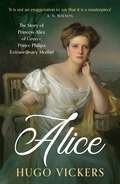
Alice: The Story of Princess Alice of Greece, Prince Philip's Extraordinary Mother
By Hugo Vickers. 2025
The remarkable, moving story of Prince Philip's mother by eminent biographer Hugo Vickers, updated in this new edition - for…
fans of Kingmaker and The Lives and Deaths of the Princesses of Hesse'Gripping. Hugo Vickers has pulled off an extraordinary feat in describing the life - in many ways tragic - of Princess Andrew of Greece. It is not an exaggeration to say that this is a masterpiece.' - A. N. Wilson'Vickers tells this story with a sure touch and an expertise that only he can command' SUNDAY TIMES'A sympathetic, piquant and well-defined portrait of a spirited woman' LITERARY REVIEW'Sympathetic yet free of pathos, Vickers's life celebrates an unusual and fascinating woman' KIRKUS--------Princess Alice, mother of Prince Phillip, was something of a mystery figure even within her own family. Profoundly deaf, she was born at Windsor Castle in the presence of her great-grandmother, Queen Victoria, and brought up in England, Darmstadt, and Malta.In 1903 she married Prince Andrew of Greece and Denmark, and from then on her life was overshadowed by wars, revolutions, enforced periods of exile. Further crisis hit when, at the age of forty-five, she was removed from her family and placed in a sanatorium in Switzerland, where she was pronounced a paranoid schizophrenic. As her stay in the clinic became prolonged, there was a time where it seemed she might never walk free again.Yet she recovered.Illuminating and enthralling, eminent biographer Hugo Vickers's account of her life is as tumultuous and extraordinary as the times she lived through.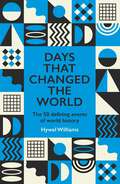
Days That Changed the World: The 50 Defining Events of World History
By Hywel Williams. 2025
The currents of History run deep and often unseen beneath the everyday ripple of events. But now and again the…
current rises to the surface, and the events of a single day shed an exceptional light on the meaning of the past.Such events are the subject of Days that Changed the World. Some of the 50 days described here mark the end of an era; others the start of something new. Many are the dates of bloody battles or murders; others of momentous decisions or breathtaking discoveries. All are remembered as powerful symbols of their time.Our story begins almost 2500 years ago on 28 September 480 before the Christian Era, when the Athenian navy destroyed the Persian invasion fleet in the Bay of Salamis. Had the Persians won we might never have heard the names of Plato, Aristotle or Alexander, nor recognize the word democracy. Charting 50 such defining moments, concluding with Nelson Mandela's release from prison in 1990 and 9/11 a decade after, Days that Changed the World is a unique and fascinating way to portray the story of world history.Repackaged into a neat and striking format, with a brand new cover and an entirely narrative approach, it is bound to be anyone interested in History's favourite encyclopaedia.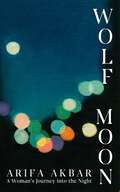
Wolf Moon: A Woman's Journey into the Night
By Arifa Akbar. 2025
'A beautifully written combination of personal reflection and broader thought . . . at once atmospheric and touching' Louise Doughty,…
author of Apple Tree Yard'Had me entranced from start to finish . . . an absolute joy'Lucy Atkins, author of Windmill Hill'A deft, rich and intimate exploration of darkness in all its varied guises'Annabel Abbs, author of Sleepless'Truthful, lyrical and unforgettable'Yasmin Alibhai-BrownThe night is a time of darkness and nightmares, fear and vulnerability, especially for women. And, yet, it is another world, full of beauty and possibility, too.After the sun goes down, insomnia and sleep paralysis do threaten. But some have always walked the nocturnal landscapes, with more or less confidence. Others have worked, night shifts and hidden night work: nurses, security guards, sex workers. And some have found solace in the darkness, from queer rave culture to religious pre-dawn traditions.From dusk through to day, Arifa Akbar elegantly explores how the night shapes our bodies, minds and cultures. A personal and artistic journey from fear and into hope, Wolf Moon embraces the dark before bringing us, once more, into the light.Praise for Consumed:⭐ 'Beguiling . . . this one stands out for its eccentricity and elegiac splendour' Diana Evans, Guardian⭐ 'Moving, engrossing, elegantly written' Sunday Times⭐ 'I have rarely read a memoir with such a combination of powerful, tender feelings and cool-headed analysis' Mail on Sunday
Alice: The Story of Princess Alice of Greece, Prince Philip's Extraordinary Mother
By Hugo Vickers. 2025
The remarkable, moving story of Prince Philip's mother by eminent biographer Hugo Vickers, updated in this new edition - for…
fans of Kingmaker and The Lives and Deaths of the Princesses of Hesse'Gripping. Hugo Vickers has pulled off an extraordinary feat in describing the life - in many ways tragic - of Princess Andrew of Greece. It is not an exaggeration to say that this is a masterpiece.' - A. N. Wilson'Vickers tells this story with a sure touch and an expertise that only he can command' SUNDAY TIMES'A sympathetic, piquant and well-defined portrait of a spirited woman' LITERARY REVIEW'Sympathetic yet free of pathos, Vickers's life celebrates an unusual and fascinating woman' KIRKUS--------Princess Alice, mother of Prince Phillip, was something of a mystery figure even within her own family. Profoundly deaf, she was born at Windsor Castle in the presence of her great-grandmother, Queen Victoria, and brought up in England, Darmstadt, and Malta.In 1903 she married Prince Andrew of Greece and Denmark, and from then on her life was overshadowed by wars, revolutions, enforced periods of exile. Further crisis hit when, at the age of forty-five, she was removed from her family and placed in a sanatorium in Switzerland, where she was pronounced a paranoid schizophrenic. As her stay in the clinic became prolonged, there was a time where it seemed she might never walk free again.Yet she recovered.Illuminating and enthralling, eminent biographer Hugo Vickers's account of her life is as tumultuous and extraordinary as the times she lived through.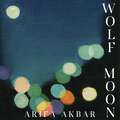
Wolf Moon: A Woman's Journey into the Night
By Arifa Akbar. 2025
'A beautifully written combination of personal reflection and broader thought . . . at once atmospheric and touching' Louise Doughty,…
author of Apple Tree Yard'Had me entranced from start to finish . . . an absolute joy'Lucy Atkins, author of Windmill Hill'A deft, rich and intimate exploration of darkness in all its varied guises'Annabel Abbs, author of Sleepless'Truthful, lyrical and unforgettable'Yasmin Alibhai-BrownThe night is a time of darkness and nightmares, fear and vulnerability, especially for women. And, yet, it is another world, full of beauty and possibility, too.After the sun goes down, insomnia and sleep paralysis do threaten. But some have always walked the nocturnal landscapes, with more or less confidence. Others have worked, night shifts and hidden night work: nurses, security guards, sex workers. And some have found solace in the darkness, from queer rave culture to religious pre-dawn traditions.From dusk through to day, Arifa Akbar elegantly explores how the night shapes our bodies, minds and cultures. A personal and artistic journey from fear and into hope, Wolf Moon embraces the dark before bringing us, once more, into the light.Praise for Consumed:⭐ 'Beguiling . . . this one stands out for its eccentricity and elegiac splendour' Diana Evans, Guardian⭐ 'Moving, engrossing, elegantly written' Sunday Times⭐ 'I have rarely read a memoir with such a combination of powerful, tender feelings and cool-headed analysis' Mail on Sunday
Days That Changed the World: The 50 Defining Events of World History
By Hywel Williams. 2025
The currents of History run deep and often unseen beneath the everyday ripple of events. But now and again the…
current rises to the surface, and the events of a single day shed an exceptional light on the meaning of the past.Such events are the subject of Days that Changed the World. Some of the 50 days described here mark the end of an era; others the start of something new. Many are the dates of bloody battles or murders; others of momentous decisions or breathtaking discoveries. All are remembered as powerful symbols of their time.Our story begins almost 2500 years ago on 28 September 480 before the Christian Era, when the Athenian navy destroyed the Persian invasion fleet in the Bay of Salamis. Had the Persians won we might never have heard the names of Plato, Aristotle or Alexander, nor recognize the word democracy. Charting 50 such defining moments, concluding with Nelson Mandela's release from prison in 1990 and 9/11 a decade after, Days that Changed the World is a unique and fascinating way to portray the story of world history.Repackaged into a neat and striking format, with a brand new cover and an entirely narrative approach, it is bound to be anyone interested in History's favourite encyclopaedia.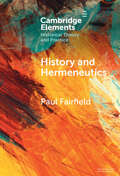
History and Hermeneutics (Elements in Historical Theory and Practice)
By Paul Fairfield. 2025
Philosophical hermeneutics has shed a good deal of light both upon the methodological underpinnings of the humanities and social sciences…
generally and in particular upon some fundamental issues in the philosophy of history and history proper. The aim in this Element is to analyze those of its arguments that bear directly upon the latter fields. The principal topics taken up are Dilthey's distinction between understanding and explanation, the accent on meaning and experience, and the sense in which we may be said to belong to history. Heidegger's account of historicity and being-in-the-world, Gadamer's conceptions of historical understanding and belonging, and Ricoeur's view of historians as storytellers also come in for analysis. Other themes include the sense in which we may speak of a dialogue with the past, the notion of historical truth, and the problem of constructivism.
Forbidden fruit: love stories from the Underground Railroad
By Betty DeRamus. 2005
A collection of stories drawn from such sources as memoirs and interviews of slave's descendants describe courageous actions taken by…
people to save their love during the reign of slavery in the United States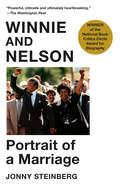
Winnie and Nelson: Portrait of a Marriage
By Jonny Steinberg. 2023
A NATIONAL BOOK CRITICS CIRCLE AWARD WINNER • THE SUNDAY TIMES LITERARY AWARD WINNER • AN LA TIMES BOOK PRIZE FINALIST •…
A WASHINGTON POST AND NEW YORKER BEST BOOK OF THE YEAR • A deeply researched, shattering new account of Nelson Mandela&’s relationship with Winnie Madikizela-Mandela that &“does justice both to the couple&’s political heroism and to the betrayals and the secrets that hounded their union&” (The New Yorker).Drawing on never-before-seen material, Steinberg—one of South Africa&’s foremost nonfiction writers—reveals the fractures and stubborn bonds at the heart of a volatile and groundbreaking union, a very modern political marriage that played out on the world stage.&“Powerful, intimate.&” —The Washington PostOne of the most celebrated political leaders of a century, Nelson Mandela has been written about by many biographers and historians. But in one crucial area, his life remains largely untold: his marriage to Winnie Madikizela-Mandela. During his years in prison, Nelson grew ever more in love with an idealized version of his wife, courting her in his letters as if they were young lovers frozen in time. But Winnie, every bit his political equal, found herself increasingly estranged from her jailed husband&’s politics. Behind his back, she was trying to orchestrate an armed seizure of power, a path he feared would lead to an endless civil war.Jonny Steinberg tells the tale of this unique marriage—its longings, its obsessions, its deceits—making South African history a page-turning political biography. Winnie and Nelson is a modern epic in which trauma doesn&’t affect just the couple at its center, but an entire nation. It is also a Shakespearean drama in which bonds of love and commitment mingle with timeless questions of revolution, such as whether to seek retribution or a negotiated peace. Steinberg reveals, with power and tender emotional insight, how far these forever-entwined leaders would go for each other and where they drew the line. For in the end, both knew theirs was not simply a marriage, but a contest to decide how apartheid should be fought.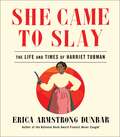
She Came to Slay: The Life and Times of Harriet Tubman
By Erica Armstrong Dunbar. 2019
In the bestselling tradition of The Notorious RBG comes a lively, informative, and illustrated tribute to one of the most…
exceptional women in American history—Harriet Tubman—a heroine whose fearlessness and activism still resonate today.Harriet Tubman is best known as one of the most famous conductors on the Underground Railroad. As a leading abolitionist, her bravery and selflessness has inspired generations in the continuing struggle for civil rights. Now, National Book Award nominee Erica Armstrong Dunbar presents a fresh take on this American icon blending traditional biography, illustrations, photos, and engaging sidebars that illuminate the life of Tubman as never before. Not only did Tubman help liberate hundreds of slaves, she was the first woman to lead an armed expedition during the Civil War, worked as a spy for the Union Army, was a fierce suffragist, and was an advocate for the aged. She Came to Slay reveals the many complexities and varied accomplishments of one of our nation&’s true heroes and offers an accessible and modern interpretation of Tubman&’s life that is both informative and engaging. Filled with rare outtakes of commentary, an expansive timeline of Tubman&’s life, photos (both new and those in public domain), commissioned illustrations, and sections including &“Harriet By the Numbers&” (number of times she went back down south, approximately how many people she rescued, the bounty on her head) and &“Harriet&’s Homies&” (those who supported her over the years), She Came to Slay is a stunning and powerful mix of pop culture and scholarship and proves that Harriet Tubman is well deserving of her permanent place in our nation&’s history.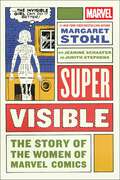
Super Visible: The Story of the Women of Marvel Comics
By Margaret Stohl. 2025
Inspired by the hit podcast The Women of Marvel and cowritten by the #1 New York Times bestselling coauthor of…
Beautiful Creatures, this eye-opening and engaging book celebrates the women who have helped make Marvel one of the most successful comics and entertainment companies in the world.What does a hero&’s journey look like when the hero in question happens to be a girl? #1 New York Times bestselling author and Marvel creator Margaret Stohl (The Life of Captain Marvel, Black Widow: Forever Red) along with Judith Stephens (producer and cocreator of the Women of Marvel podcast), and Jeanine Schaefer (critically acclaimed editor) interviewed more than a hundred women and nonbinary Marvel contributors in search of the answer to that question. With one shared goal—to make the historically invisible work of women visible—and with unprecedented access to Marvel creators, writers, and more, Stohl, Stephens, and Schaefer set out to tell the story of the women of the &“House of Ideas&” from 1939 through today, and along the way, to find the meaning of their own Marvel stories. Packed with biographies and illustrations from creators, graphical reprints and excerpts of historic Marvel comics, and exclusive interviews from acclaimed directors like Anna Boden and Cate Shortland; lauded writers such as Kelly Sue DeConnick, Eve Ewing, Rainbow Rowell, Nic Stone, G. Willow Wilson, Tini Howard, and Maurene Goo; top artists like Jen Bartel; and influential producer Sana Amanat, Super Visible: The Story of the Women of Marvel is an essential read for fans of all ages.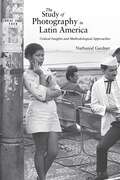
The Study of Photography in Latin America: Critical Insights and Methodological Approaches
By Nathanial Gardner. 2023
In this book Nathanial Gardner provides an insider&’s perspective to the study of photography in Latin America. He begins with…
a carefully structured introduction that lays out his unique methodology for the book, which features over eighty photographs and the insights from sixteen prominent Latin American photography scholars and historians, including Boris Kossoy, John Mraz, and Ana Mauad. The work reflects the advances and developments of the study of photography throughout Latin America with certain emphasis on Brazil and Mexico. The author further underlines the role of important institutions and builds context by discussing influential theories and key texts that currently guide the discipline. The Study of Photography in Latin America is critical to all who want to expand their current knowledge of the subject and engage more robustly with its experts.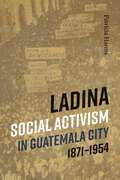
Ladina Social Activism in Guatemala City, 1871-1954
By Patricia Harms. 2020
In this groundbreaking new study on ladinas in Guatemala City, Patricia Harms contests the virtual erasure of women from the…
country&’s national memory and its historical consciousness. Harms focuses on Spanish-speaking women during the &“revolutionary decade&” and the &“liberalism&” periods, revealing a complex, significant, and palpable feminist movement that emerged in Guatemala during the 1870s and remained until 1954. During this era ladina social activists not only struggled to imagine a place for themselves within the political and social constructs of modern Guatemala, but they also wrestled with ways in which to critique and identify Guatemala&’s gendered structures within the context of repressive dictatorial political regimes and entrenched patriarchy. Harms&’s study of these women and their struggles fills a sizeable gap in the growing body of literature on women&’s suffrage, social movements, and political culture in modern Latin America. It is a valuable addition to students and scholars studying the rich history of the region.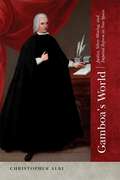
Gamboa's World: Justice, Silver Mining, and Imperial Reform in New Spain (Diálogos Series)
By Christopher Albi. 2021
Gamboa&’s World examines the changing legal landscape of eighteenth-century Mexico through the lens of the jurist Francisco Xavier de Gamboa…
(1717–1794). Gamboa was both a representative of legal professionals in the Spanish world and a central protagonist in major legal controversies in Mexico. Of Basque descent, Gamboa rose from an impoverished childhood in Guadalajara to the top of the judicial hierarchy in New Spain. He practiced law in Mexico City in the 1740s, represented Mexican merchants in Madrid in the late 1750s, published an authoritative commentary on mining law in 1761, and served for three decades as an Audiencia magistrate. In 1788 he became the first locally born regent, or chief justice, of the High Court of New Spain. In this important work, Christopher Albi shows how Gamboa&’s forgotten career path illuminates the evolution of colonial legal culture and how his arguments about law and justice remain relevant today as Mexico debates how to strengthen the rule of law.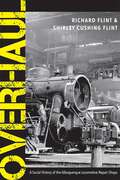
Overhaul: A Social History of the Albuquerque Locomotive Repair Shops
By Richard Flint, Shirley Cushing Flint. 2021
In Overhaul, historians Richard Flint and Shirley Cushing Flint present the largely forgotten story of Albuquerque&’s locomotive repair shops, which…
were the driving force behind the city&’s economy for more than seventy years. In the course of their study they also document the thousands of skilled workers who kept the locomotives in operation, many of whom were part of the growing Hispano and Native American middle class. Their critical work kept the Atchison, Topeka, and Santa Fe&’s steam trains running and established and maintained Albuquerque&’s unique character in the region.Including a generous selection of historic photographs, Overhaul provides a glimpse into the people, places, culture, and special history found in Albuquerque&’s locomotive shops during the boom of steam railroading. The Flints provide an engaging and informative account of how these shops and workers played a crucial role in the formation and development of the Duke City.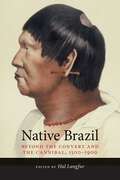
Native Brazil: Beyond the Convert and the Cannibal, 1500-1900 (Diálogos Series)
By Hal Langfur. 2014
The earliest European accounts of Brazil&’s indigenous inhabitants focused on the natives&’ startling appearance and conduct—especially their nakedness and cannibalistic…
rituals—and on the process of converting them to clothed, docile Christian vassals. This volume contributes to the unfinished task of moving beyond such polarities and dispelling the stereotypes they fostered, which have impeded scholars&’ ability to make sense of Brazil&’s rich indigenous past. This volume is a significant contribution to understanding the ways Brazil&’s native peoples shaped their own histories. Incorporating the tools of anthropology, geography, cultural studies, and literary analysis, alongside those of history, the contributors revisit old sources and uncover new ones. They examine the Indians&’ first encounters with Portuguese explorers and missionaries and pursue the consequences through four centuries. Some of the peoples they investigate were ultimately defeated and displaced by the implacable advance of settlement. Many individuals died from epidemics, frontier massacres, and forced labor. Hundreds of groups eventually disappeared as distinct entities. Yet many others found ways to prolong their independent existence or to enter colonial and later national society, making constrained but pivotal choices along the way.
The Bare-toed Vaquero: Life in Baja California's Desert Mountains
By Peter J. Marchand. 2013
Rarely visited by outsiders, the ranchers of the Sierra de la Giganta in Baja California Sur live much as their…
ancestors have for the past two centuries. They raise goats and cattle and grow a magnificent variety of fruits, vegetables, and flowers. In this book a gifted photojournalist introduces us to individual ranchers and their families and describes their traditional practices and the ways they have adapted to twenty-first-century challenges and technological advances. Marchand&’s photographs and text are both informative and intimate. His introduction to this little-known corner of Mexico will delight travelers and scholars alike.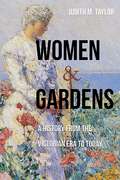
Women and Gardens: A History from the Victorian Era to Today
By Judith M. Taylor. 2025
Judith M. Taylor&’s Women and Gardens highlights the depth and breadth of women&’s influence on gardens and landscapes in the…
last two hundred years and reveals many unknown or intentionally ignored facts concerning the roles of women in gardening and their contributions to horticultural science. Over eight chapters that investigate the obstacles and opportunities women have encountered in gardening, this book explores the history of women in horticulture, landscape design, and ornamental plant breeding from the Victorian era to today.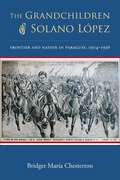
The Grandchildren of Solano López: Frontier and Nation in Paraguay, 1904–1936
By Bridget María Chesterton. 2013
Paraguay&’s Chaco frontier, one of the least known areas in one of the least known countries in South America, became…
the unexpected scene of the bloodiest international war in the Americas, the Chaco War between Paraguay and Bolivia (1932–35).A picture postcard from the Chaco War era shows a large heart, emblazoned with the word &“Paraguayo,&” pumping its way through the flat dusty wilderness of the Chaco and leaving a zigzag trail of smashed Bolivian forts and soldiers along the way. This visual propaganda shows why the Paraguayans were sure they would win the war: they were brave, passionate soldiers. They considered themselves invincible descendants of the great hero of the War of the Triple Alliance (1864–70), Marshal Francisco Solano López (El Mariscal).But Solano López was not universally revered. A controversial figure, he was widely believed to have led Paraguay into economic, social, and cultural ruin. The debate over López&’s actions shaped the country&’s culture and politics for over a century after the War of the Triple Alliance. Bridget María Chesterton&’s in-depth examination of Paraguay&’s unique nationalism and the role of the frontier in its formation places the debate over López in the context of larger themes of Latin American history, including racial and ethnic identity, authoritarian regimes, and militarism.